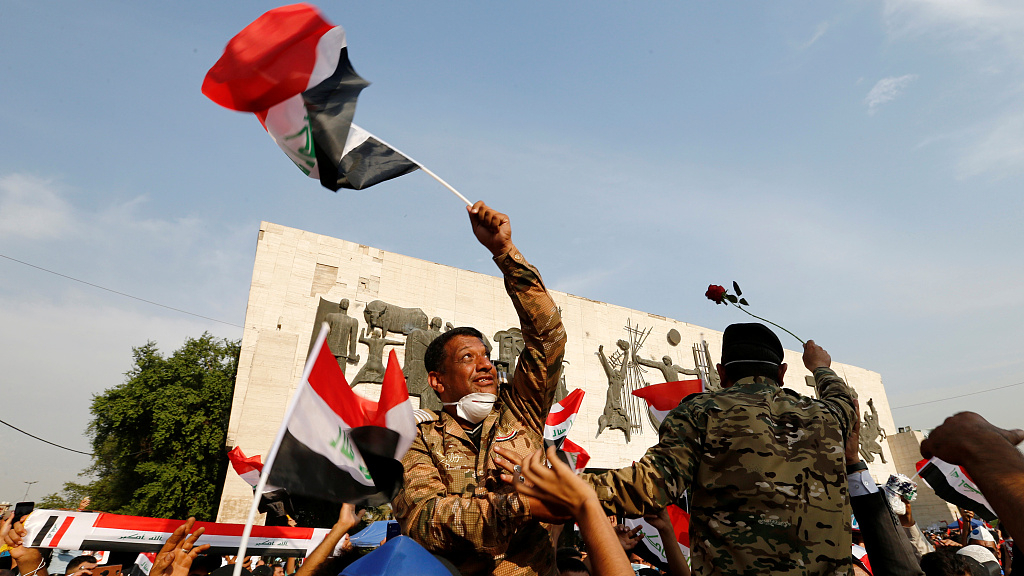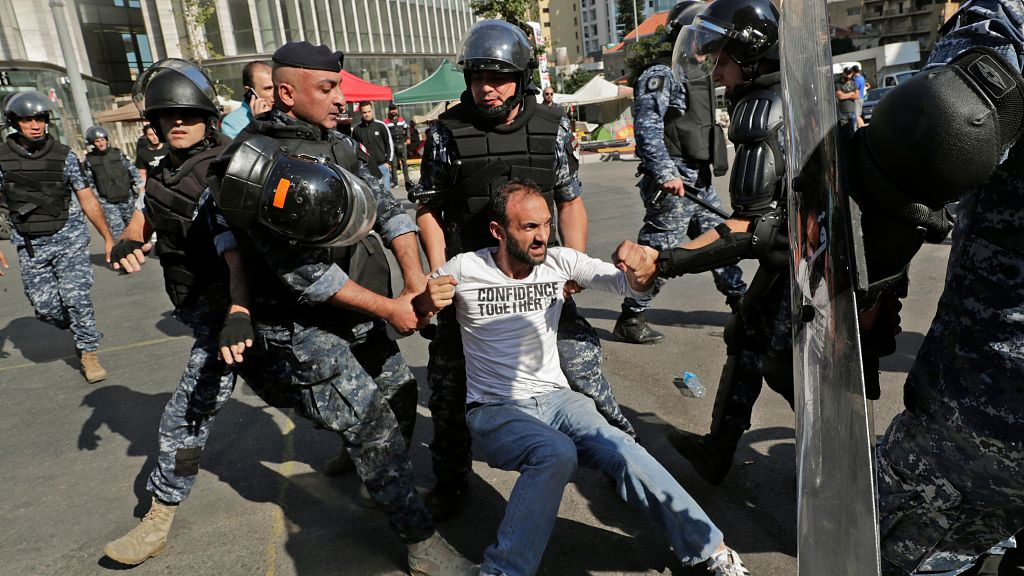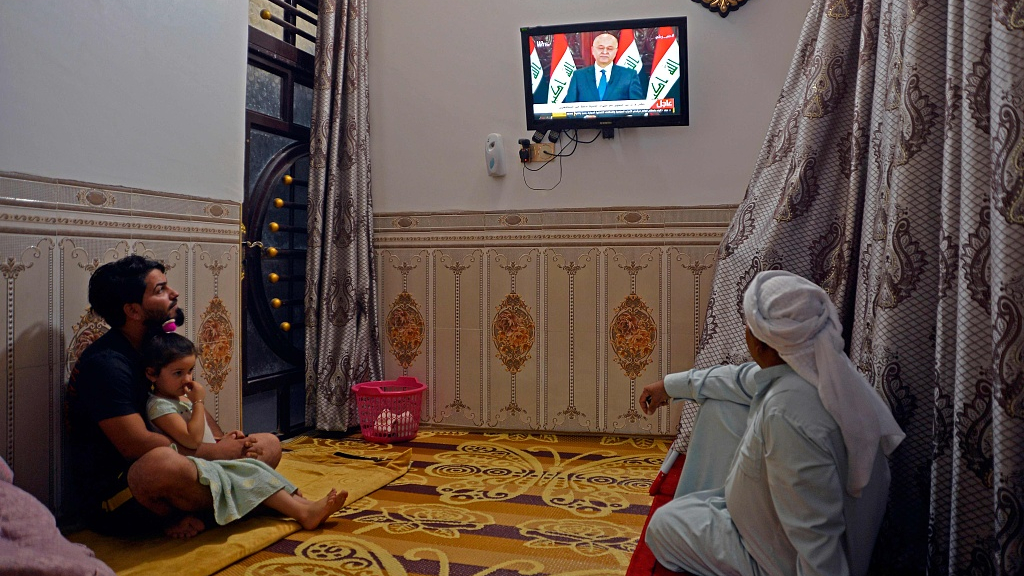
A protest over corruption, lack of jobs, and poor services, in Baghdad, Iraq, October 27, 2019. /VCG Photo
A protest over corruption, lack of jobs, and poor services, in Baghdad, Iraq, October 27, 2019. /VCG Photo
Editor's Note: Guy Burton is a visiting fellow at the Middle East Center, London School of Economics, and adjunct professor at Vesalius College, Brussels. The article reflects the author's opinions, and not necessarily the views of CGTN.
As the protests in Lebanon and Iraq not only grow bigger but also claim significant victories – including the recent resignation of Lebanese Prime Minister Saad Hariri – there has been speculation that a new Arab Spring may be on the horizon. Is that the case and what are the prospects for the protest movements in both countries as well as the wider region?
The short answer as to whether the current upheaval is an Arab Spring 2.0 is no. The longer answer requires a bit more explanation. Namely that the current wave of regional protest is linked to the earlier ones which began in 2011. Although some of the protest movements were contained and suppressed in some part of the region back then, the issues and sentiments which drove people onto the streets eight years ago are still present today. Indeed, they never went away.
Despite the different triggers which gave rise to the demonstrations in each country in the last month, both the Lebanese and Iraqi protest movements share some common features. Both represent frustration with not only the government, but the political class as a whole. Demonstrators are angry with politicians' failure to provide both basic public services as well as the prospects for a reasonable quality of life.
They are also striking for being largely free of the sectarianism which dominates elite level politics in both countries: protesters have made a common effort to emphasize their movement as a national one which doesn't privilege any one religious or ethnic community or exclude others. Doing this is also practical, since it has made it harder for political leaders to co-opt the movement for their own advantage.
The Lebanese and Iraqi protests aren't the only ones that have occurred in the Middle East this year – and which has perhaps prompted some to question if another Arab Spring is taking place.

Lebanese riot police officers remove an anti-government protester in Beirut, October 31, 2019. /VCG Photo
Lebanese riot police officers remove an anti-government protester in Beirut, October 31, 2019. /VCG Photo
Earlier in the year, Algerians took to the street after 82-year old President Abdelaziz Bouteflika announced he was standing for election for a fifth time. Although they forced his resignation in April, they continue to protest, demanding an end to the military which has ruled the country since independence even in the face of a clampdown by security forces.
Like in Lebanon and Iraq, economic factors underpinned the protests in Algeria. The fall in oil prices since 2014 for Algeria has been felt, with less revenue to subsidize basic amenities or promote economic reforms. In Algeria, economic reform will be difficult to achieve when the political elite and business are so closely bound to each other.
The issues at stake in all these countries which are experiencing protest today – economic stagnation, government failure and ineffectiveness and public frustration – were also present in 2011. They underpinned the mass demonstrations which took place in Tunisia and Egypt in January and February that year, leading to the resignation of both countries' presidents.
One key difference between those protests and today was protesters' decision to identify with their regional peers then. Because of this, Libya's Muammar Gaddafi and Syria's Bashar al-Assad made it clear that they would not give in to protesters' demands when the movement reached their countries. Gaddafi was eventually killed in the armed rebellion he inspired while Assad seems on the brink of a pyrrhic victory with his Russian and Iranian backers after eight years of war.
Other administrations, including the Saudi and UAE leaderships, also sought to curb the regional spread of the 2011 protests. As well as offering some incentives for their population, they also used arrests, detainment and the use of online and offline surveillance to deter opposition. In Saudi Arabia, several women activists who campaigned for the right to drive are in prison awaiting trial. In the UAE, regulations for social media use have been introduced while social influencers promote the leadership's version of events.

Iraqis watch a televised speech by Iraq's President Barham Saleh in the central holy shrine city of Najaf, October 31, 2019. /VCG Photo
Iraqis watch a televised speech by Iraq's President Barham Saleh in the central holy shrine city of Najaf, October 31, 2019. /VCG Photo
The Egyptian coup, Syria's escalating violence and the Gulf-led backlash arguably overshadowed the protests which had set in motion events which eventually led to that point. But the uprisings which began in 2011 were not a one-off. They were the consequence of poor economic performance and unresponsive governments which had their origins long before 2011.
Indeed, both the United Nations (through its UN Development Program) and the World Bank have reported on the limited employment, education and political opportunities for the region's young people in several reports since 2000 at least.
A central theme is the breakdown of the region's social contract. Since independence, most regional governments have offered public services and public sector jobs in exchange for not challenging the administration. That worked so long as countries were beneficiaries of large rents, whether in the form of energy revenue among oil and gas producers or through foreign aid for those without oil.
But with foreign aid and energy price levels declining, governments are facing growing pressure as they fail to keep their side of the bargain – and which is demonstrated by the continuing eruption of protest across the region. Until governments begin to grapple with that issue and improve their people's lives for the better, demonstrations are likely to become a feature of political life in the Middle East.
(If you want to contribute and have specific expertise, please contact us at opinions@cgtn.com.)